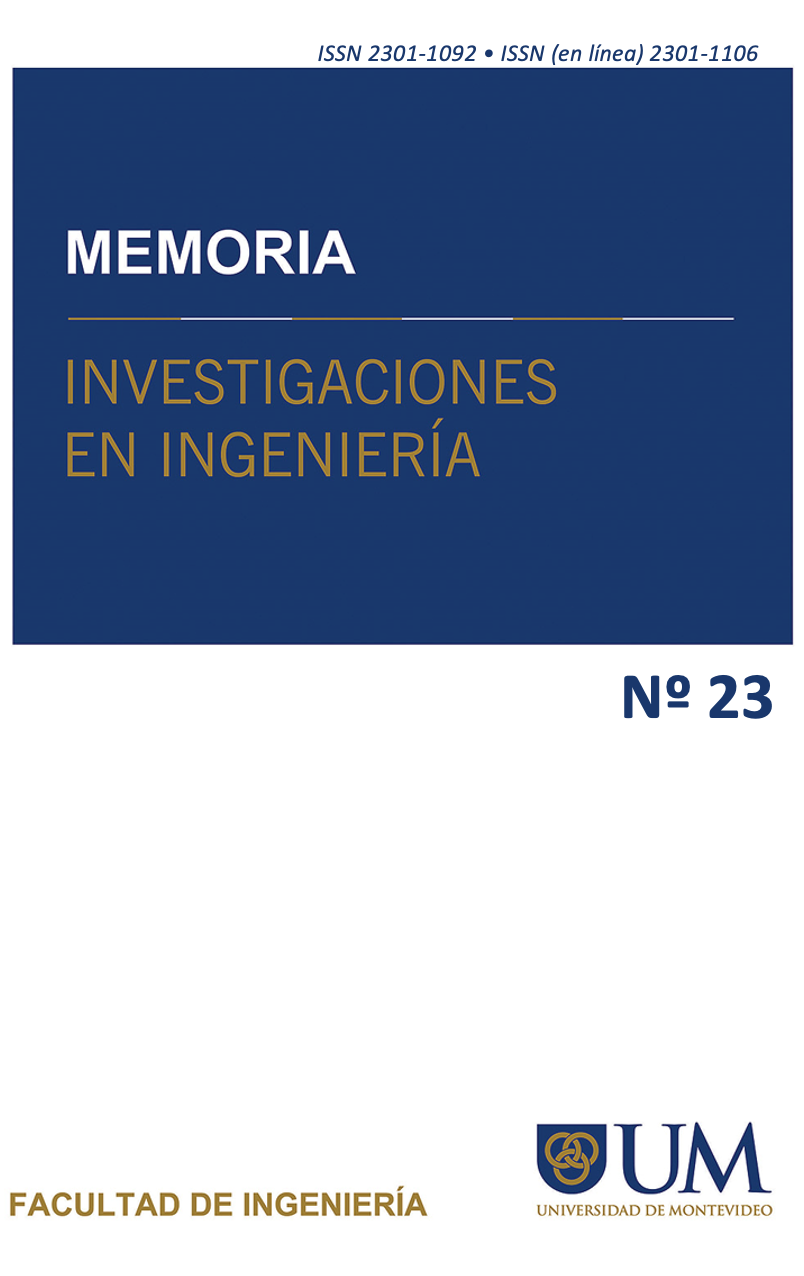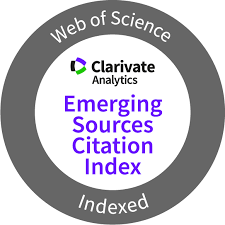Implementation and Evaluation of a Hail-Impact Simulation Device
DOI:
https://doi.org/10.36561/ING.23.11Keywords:
Hail-Impact Simulator, Energy Matching, Calibration, Sensor, DesignAbstract
Hailstorms are hazardous for people and goods. Automatically collecting information on hailstorms will help climate researchers analyze them and generate models for forecasting. Reproducing hail impacts is a requisite for designing and calibrating an electronic hail sensor. In this article, the design of a device for hail-impact simulation is presented. This device is based on the theory of Energy Matching, which explains how steel balls can be used instead of hailstones in order to have equivalent impact energies. The posed device, which can perform up to fourteen impacts between loading instances, either by dropping balls one by one or in pairs, was constructed. The size of the balls can be between 0.5 cm and 3.0 cm. In this paper, which is an extension of the work originally presented at the URUCON2021 conference, the importance of having such a hail-impact simulation device is explained. The main contribution of this extended work is the presentation of an experiment performed as an application of the constructed device. This experiment has the objective of verifying the aiming repetitiveness, while also verifying the linear relation between impact and electric signal energies.
Downloads
References
F. Blasina, A. Echarri, G. Farber, F. Molina, S. Machin, and N. Pérez, “Why and how to construct a device for hail simulation,” in 2021 IEEE URUCON, 2021, pp. 450–454.
S. A. Changnon Jr, “Hailfall characteristics related to crop damage,” Journal of Applied Meteorology (1962-1982), pp. 270–274, 1971.
Y. Yue, L. Zhou, A.-x. Zhu, and X. Ye, “Vulnerability of cotton subjected to hail damage,” PLOS ONE, vol. 14, no. 1, pp. 1–21, 01 2019.
H. Seino, “On the characteristics of hail size distribution related to crop damage,” Journal of Agricultural Meteorology, vol. 36, no. 2, pp. 81–88, 1980.
J. Deepen, “Schadenmodellierung extremer hagelereignisse in deutschland,” Westfälischen Wilhelms-Universität Münster, 2006.
E. Eccel, P. Cau, K. Riemann-Campe, and F. Biasioli, “Quantitative hail monitoring in an alpine area: 35-year climatology and links with atmospheric variables,” International journal of climatology, vol. 32, no. 4, pp. 503–517, 2012.
M. Aran, J. Pena, and M. Torà, “Atmospheric circulation patterns associated with hail events in lleida (catalonia),” Atmospheric research, vol. 100, no. 4, pp. 428–438, 2011.
L. Rijo and F. Santiñaque, “Investigación de metodologías para el análisis espacio-temporal del evento granizo en uruguay,” 2011.
G. B. Foote and C. Knight, “Hail: a review of hail science and hail suppression,” 2016.
S. A. Changnon, “The scales of hail,” Journal of Applied Meteorology and Climatology, vol. 16, no. 6, pp. 626–648, 1977.
“El Observador: Hailstorm damages for US$ 5M and 13 thousand seasonal workplaces at risk. Granizada en Salto dejó daños por US$ 5 millones y 13 mil empleos zafrales en riesgo,” t.ly/Bo1P, 2018-06, accessed 2021-07.
“La Prensa: Hailfall generated important losses. Caída de granizo generó importantes pérdidas,”
t.ly/0fYz, 2020-04, accessed 2021-07.
“El Observador: Two hailstorms will cost US$ 2.5m in indemnizations. Dos granizadas costarán US$ 2.5 millones en indemnizaciones,” t.ly/hXfG, 2017-11, accessed 2021-07.
S. Changnon, E. Fosse, and E. Lecomte, “Interactions between the atmospheric sciences and insurers in the united states,” Weather and Climate Extremes, 1999.
“Vehicle damage images,” https://blog.certifiedfirst.es/2019/10/como-afecta-el-granizo-a-lacarroceria-y-los-cristales-de-tu-coche-te-cubre-el-seguro/, 2019, 2019-10, accessed 2022-07.
L. Silveira, C. Chreties, M. Crisci, G. Usera, and J. Alonso, “Early warning system for flood forecast in Durazno city, Sistema de alerta temprana para previsión de avenidas en la ciudad de Durazno,” Innotec, no. 10, 2015.
“Gub.uy: Uruguay enhanced its early-flood-detection system. Uruguay potenció su Sistema de Alerta Temprana de inundación,” t.ly/ZgRP, 2020-07, accessed 2021-07.
G. Strong and E. Lozowski, “An alberta study to objectively measure hailfall intensity,” Atmosphere, vol. 15, no. 1, pp. 33–53, 1977.
G. Morgan Jr and N. Towery, “On the role of strong winds in damage to crops by hail and its estimation with a simple instrument,” J Appl Meteorol Clim, vol. 15, no. 8, 1976.
M. Löffler-Mang, D. Schön, and M. Landry, “Characteristics of a new automatic hail recorder,” Atmospheric research, vol. 100, no. 4, pp. 439–446, 2011.
R. Younquist, W. Haskell, C. Immer, B. Cox, and J. Lane, “Hail monitor sensor,” Tech. Rep., 2009.
I. BIPM, I. IFCC, I. IUPAC, and O. ISO, “The international vocabulary of metrology—basic and general concepts and associated terms (vim), 3rd edn. jcgm 200: 2012,” JCGM (Joint Committee for Guides in Metrology), 2012.
A. J. Heymsfield, I. M. Giammanco, and R. Wright, “Terminal velocities and kinetic energies of natural hailstones,” Geophysical Research Letters, vol. 41, no. 23, 2014.
D. Schön et al., “Precipitation sensor, especially a hail sensor, and method for detecting a precipitation particle,” Apr. 25 2017, uS Patent 9,632,211.
R. A. Schleusener and P. C. Jennings, “An energy method for relative estimates of hail intensity,” Bulletin of the American Meteorological Society, vol. 41, no. 7, 1960.
D. Vento, “The hailpad calibration for italian hail damage documentation,” Journal of Applied Meteorology, vol. 15, no. 9, 1976.
G. Amilivia, G. Iztueta, and E. Roquero, “Design of a system for testing anti-hail protections.
Diseño de sistema para ensayo de protecciones anti-granizo,” Tesis de grado. Universidad de la República (Uruguay). Facultad de Ingeniería., 2021.
A. Majdi, M. D. Alqahtani, A. Almakytah, and M. Saleem, “Fundamental study related to the development of modular solar panel for improved durability and repairability,” IET Renewable Power Generation, vol. 15, no. 7, 2021.
Doubrava, Radek, Oberthor, Martin, Belský, Petr, and Raska, Jan, “Bird and hail stone impact resistance analysis on a jet engine composite air inlet,” MATEC Web Conf., vol. 188, 2018.
E. Lozowski, R. Erb, L. Wojtiw, M. Wong, G. S. Strong, R. Matson, A. Long, D. Vento, and
P. Admirat, “The hail sensor intercomparison experiment,” Atmosphere-Ocean, vol. 16, no. 1, 1978.
P. Render and H. Pan, “Experimental studies into hail impact characteristics,” Journal of Propulsion and Power, vol. 11, no. 6, pp. 1224–1230, 1995.
A. Echarri, G. Farber, and F. Molina, “SGran - diseño de dispositivo de simulación de granizo.” Tesis de grado. Universidad de la República (Uruguay). Facultad de Ingeniería., 2022.
T. Kundu, S. Das, and K. V. Jata, “An improved technique for locating the point of impact from the acoustic emission data,” in Health Monitoring of Structural and Biological Systems 2007, vol. 6532. SPIE, 2007, pp. 191–202.
Published
How to Cite
Issue
Section
License
Copyright (c) 2022 Florencia Blasina, Andrés Echarri, Gabriel Farber, Federico Molina, Sofía Machín, Nicolás Pérez

This work is licensed under a Creative Commons Attribution 4.0 International License.






















